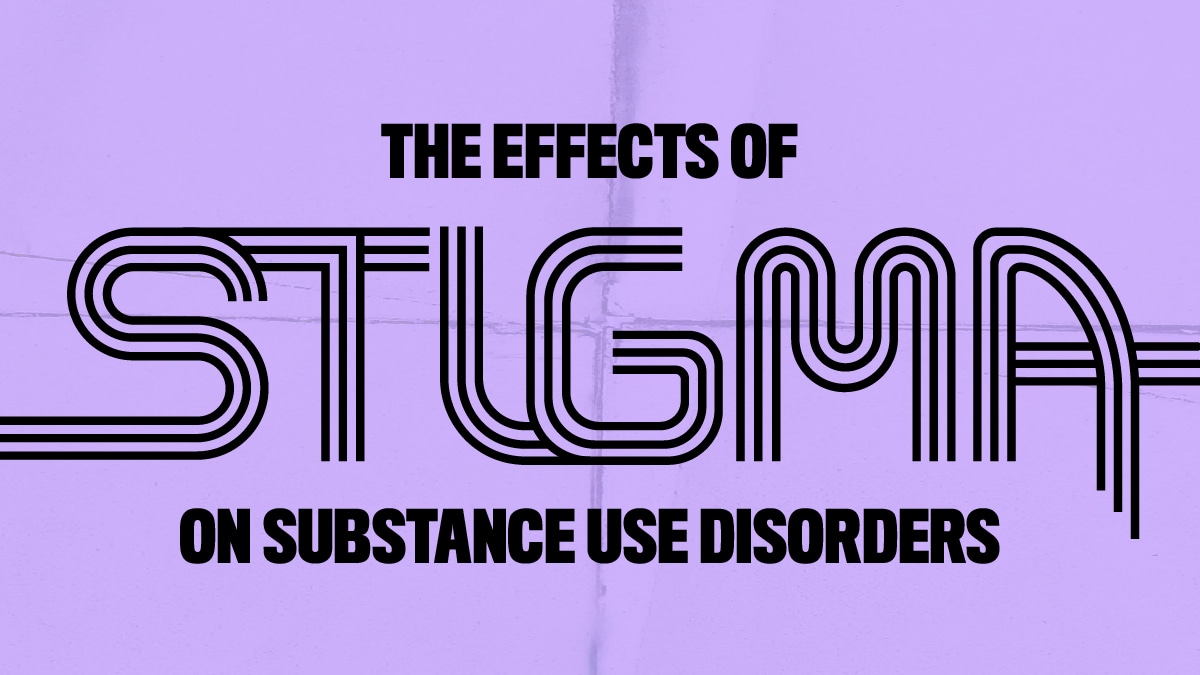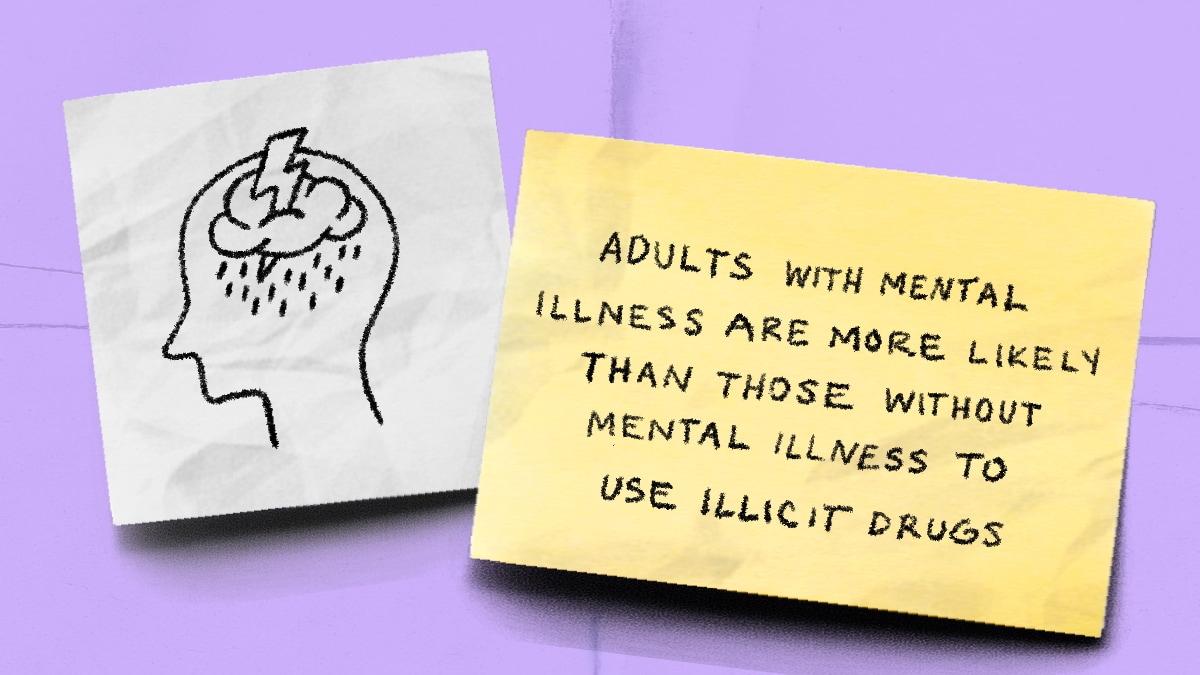At a glance
- Anyone can experience stigma, and it can make getting help harder.
- Learn more about stigma and the harmful effects it has on people with substance use disorders, and find resources that can help you understand addiction and support others.

What is stigma?
People experience feelings of stigma when another person mistreats them or thinks badly about them because of a behavior, characteristic, or trait. Stigma, whether caused by bias, purposeful exclusion, or a lack of understanding about the causes for a personal struggle, is harmful.1
Information on substance use disorder and stigma
In 2022, 54.6 million people needed substance use treatment in the past year, but 13.1 million received treatment in the past year.2 Despite the millions impacted by substance use disorders (SUDs), research shows that people tend to have negative feelings about people with SUDs.34
It's important to help share the knowledge that SUDs, like opioid use disorder (OUD), are treatable. People with SUDs need support like those with any other disease. Research suggests more than 75% of people do not consider SUDs to be a chronic illness like diabetes or heart disease.5
To help those who are living with SUDs, several strategies and services are available. Stigma can make it hard for people who need help to get the help they need, and they may refuse or stop, or even be denied treatment because of stigma.6
Stigma can impact prevention and treatment
Stigma can prevent a person from getting help. People seeking treatment for opioid use disorder may find that some healthcare professionals will not prescribe medication to treat OUD,7despite medications for opioid use disorder (MOUD) being an effective form of treatment.8Stigma or the fear of stigma can also stop someone from sharing their health condition with partners or family members. It may also prevent them from seeking the health or behavioral health services and support services they need.
Stigma can take many forms
Stigma may come from a specific person, including a loved one or clinician, or from the larger community. It may come from within, based on feelings of personal shame or failure. It may be a combination of all those sources. Examples of stigma include:
- Assuming a person chooses not to change their behavior.
- Considering SUDs to be a moral instead of a medical issue.
- Withholding instead of offering support or treatment, including MOUD, based on a belief that offering support, whether social or financial, enables a person to continue using drugs.
- Lack of support for SUD training and education among employers, first responders (law enforcement and emergency services personnel) and healthcare professionals
- Social rejection related to drug use or return to use.
- Not understanding the reasons behind SUDs, including a greater risk of developing an SUD based on a person's genetic background and their personal environment, adverse childhood experiences (ACEs), or mental health conditions. 91011
- A person's own negative feelings about their use.
- Stereotyping—making assumptions about characteristics of whole groups of people, including people who use drugs, is a form of stigma.
Stigma of mental and substance use disorders
People experiencing mental illness and those who use substances overlap, and both are stigmatized.11 Specifically, in 2022, 8.4% or 21.5 million young adults aged 18 or older had a co-occurring substance use disorder and any mental illness, and 2.9% or 7.4 million adults aged 18 or older had a co-occurring substance use disorder and any severe mental illness.12

Resources
- Video: Understanding addiction to support recovery (:60)
- CDC Podcast – Reducing Stigma-Understanding Addiction to Support Recovery [MP3 – 17 MB]
- Explore stigma reduction and other educational materials on CDC's Overdose Resource Exchange.
- Stigma, APA Dictionary of Psychology, https://dictionary.apa.org/stigma.
- https://www.samhsa.gov/data/sites/default/files/reports/rpt42731/2022-nsduh-nnr.pdf
- Colleen L Barry, PhD, MPP, Emma Elizabeth McGinty, Bernice Pescosolido, and Howard H. Goldman, M.D., Ph.D., Stigma, Discrimination, Treatment Effectiveness and Policy Support: Comparing Public Views about Drug Addiction with Mental Illness, Psychiatr Serv. 2014 Oct; 65(10): 1269–1272. Available online at https://www.ncbi.nlm.nih.gov/pmc/articles/PMC4285770/.
- Lawrence Yang,1,2 Liang Y. Wong,3 Margaux M. Grivel,3 and Deborah S. Hasin, Stigma and substance use disorders: an international phenomenon, Curr Opin Psychiatry. 2017 Sep; 30(5): 378–388. Available online at https://www.ncbi.nlm.nih.gov/pmc/articles/PMC5854406/.
- https://www.shatterproof.org/sites/default/files/2021-10/Shatterproof%20Addiction%20Stigma%20Index%202021%20Report.pdf
- The role of stigma in U.S. primary care physicians' treatment of opioid use disorder (sciencedirectassets.com)
- https://www.ncbi.nlm.nih.gov/pmc/articles/PMC5937046/
- https://nida.nih.gov/publications/research-reports/medications-to-treat-opioid-addiction/efficacy-medications-opioid-use-disorder
- Elizabeth C. Prom-Wormley, Jane Ebejer, Danielle M. Dick, and M. Scott Bowers, The Genetic Epidemiology of Substance Use Disorder: A Review, Drug Alcohol Depend. 2017 Nov 1; 180: 241–259. Available online at https://www.ncbi.nlm.nih.gov/pmc/articles/PMC5911369/.
- Mark A Bellis, DSc, Katherine A Hardcastle, MSc Dinesh Sethi, MD, Lancet Public Health 2017 Aug;2(8):e356-e366. Available online at https://www.thelancet.com/journals/lanpub/article/PIIS2468-2667(17)30118-4/fulltext.
- Christopher M Jones, Elinore F McCance-Katz, Co-occurring substance use and mental disorders among adults with opioid use disorder, Drug Alcohol Depend. 2019 Apr 1;197:78-82
- Key Substance Use and Mental Health Indicators in the United States: Results from the 2022 National Survey on Drug Use and Health, Substance Abuse and Mental Health Services Administration (SAMHSA), https://www.samhsa.gov/data/sites/default/files/reports/rpt42731/2022-nsduh-nnr.pdf
